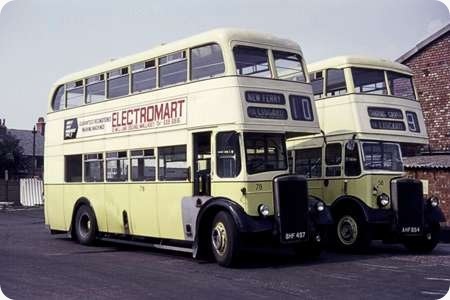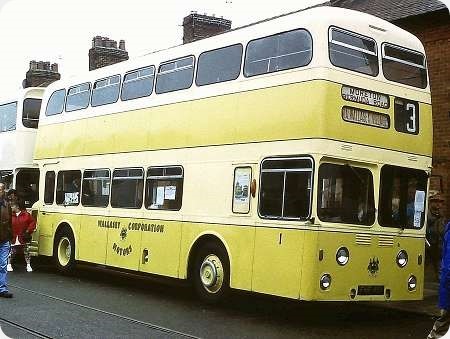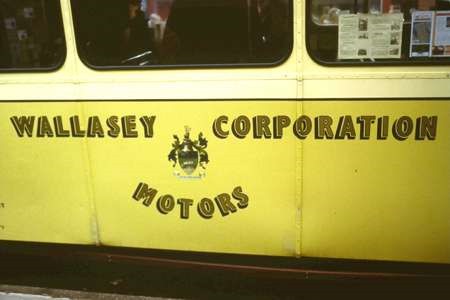
Wallasey
Corporation
Wallasey Corporation
1952
1951
Leyland Titan
PD2/12
Leyland Titan PD2/1
Weymann
H30/26R
Metro Cammell H30/26R
The 75 buses of the quaintly named Wallasey Corporation Motors was absorbed - along with those of the
Corporations of Birkenhead and Liverpool - into the newly formed Merseyside Passenger Transport
Executive on 1st December 1969.
On an enthusiasts’ visit the following August I photographed this
pair of Leyland Titans, still wearing their original livery and fleet names. I think they make an
interesting comparison.
On the left, 78 (BHF 497) is a PD2/12 with Weymann H30/26R body new in
1952. To the right, 58 (AHF 854) is a PD2/1 with Metro-Cammell H30/26R body new in 1951.
It is
quite amazing to me that this pair - both bodied by companies associated through the MCW group - were
built within a year or so of one another, the design of 58 being a throwback to the early 1930’s yet
still being built in 1951. Admittedly that on 78 can possibly also partly trace its origins back to a
Weymann design of around 1939, such as that used on Brighton Corporation’s famous FUF-registered Regents
and others, but how much more modern it looks.
Photograph and Copy contributed by John Stringer
28/02/14 - 07:55
What is equally amazing is that some eight years after 58 entered service,
Wallasey had one of the first production Atlanteans - a massive jump in design in an always
interesting fleet.
Phil Blinkhorn
28/02/14 - 07:57
What a super pair! I was taken on holiday to New Brighton in my early years
and still remember the Wallasey fleet such as those pictured. Just a pity the PTE had removed the
ornate ‘Wallasey Corporation Motors’ fleetname from the side. Only 75 buses but one of the
first Operators to put an Atlantean in service (another contender being the even smaller fleet of
James, Ammanford). I think it was in Meccano Magazine that a photo showed a temporary
‘gangplank’ being used at Seacombe ferry where the buses reversed up to the loading points
thus enabling passengers to board fleet number 1 in safety.
Ian Wild
01/03/14 - 07:10
Massive route numbers, didn’t Birkenhead have large ones as well? Perhaps lots
of short sighted passengers on the Wirral?
Ian Wild
01/03/14 - 13:39
West Bridgford did big route numbers too - as did Douglas IoM. You could tell
from three stops away whether it was your bus approaching or not! Much better than scrolling digital
displays that include bits of advertising and strange route descriptions instead of numbers.
Stephen Ford
08/10/14 - 06:58
I was employed on Wallasey buses and I was one of the first to drive an
Atlantean bus in service, I think it was route 2 from Harrison Drive to Seacombe via Liscard
Trevor Hall
15/04/15 - 10:48
Growing up in Liverpool with its 1,200 corporation buses, the Wallasey fleet
‘over the water’ was always fascinatingly old fashioned in feel and looks, even featuring a
clock on the platform giving the time of the next ferry. Always remember that when a ferry unloaded
at Seacombe and the lined-up buses filled up, a Wallasey Corporation inspector would blow his
whistle and every single bus would pull out, in convoy, bound for the posh Wallasey suburbs or New
Brighton.
Mr Anon
02/09/15 - 07:09
I grew up in Wallasey in the fifties and remember the affection we had for our
bus fleet. The shared routes such as 9, 10 and 11 with Birkenhead would always cause conflict with
yellow and blue buses leapfrogging in rush hour to maximise custom. I recall the annual outings to
Helsby when at least 10 Wallasey buses would take us urchins on a day out with a slap up tea and
games, I would try to get an upstairs front seat and if possible on bus number 80 which was my
adopted favourite.
Alan Johnstone
03/09/15 - 07:12
The interesting thing about Mr Anon’s description of the look and feel of
Wallasey buses is that in 1958, of course, Wallasey Corporation Motors was the first operator in the
country to put a new-fangled rear-engined double decker into service. But step aboard that bus, and
its interior is just as "fascinatingly old-fashioned in feel and looks" as everything else
was.
Peter Williamson
05/02/18 - 06:39
I grew up in Wallasey in the late 50’s, 60’s. We used to call the Atlanteans
the ‘new buses’. Later in 1974 I trained as a bus driver with MPTE. We were called Instant
Whips by the older drivers because we had never been conductors. I often drove some of the original
Atlanteans which were still in service. Historic but not as nice to drive as the new ones which we
called Jumbos. Later I drove for Crosville where they still had lots of back loaders and conductors.
I then drove for Henry C Cox of New Brighton, one of the nicest men and best boss I ever had.
Dan Kelly
13/09/18 - 06:48
Dan, I grew up in Wallasey in the 60s and 70s, and remember well the period
you mention. I was wondering though if you know what happened to the Cox’s Coaches business? We used
them for trips to Blackpool and Lancaster, but the seem to have vanished without trace. I was asking
around about then at the end of last year, but no one I spoke to could recall them.
J Lynch
26/02/19 - 07:18
My grandparents: Mr and Mrs Rupert Jones lived in Grosvenor Drive in the
1960s. Grandad drove the buses and my sister and I used to rollerskate all the way to Birkenhead
along the prom to take him his sandwiches! We loved it when he drove the number 1 yellow
double-decker bus, because we used to board that one to go to the "Guinea Gap" swimming
baths. He used to bring home bus tickets, ticket machines and Wallasey Corporation Driver uniform
caps and silver buttons for us to play with. Happy days
Marianne Baddeley
27/02/19 - 07:16
Has the Weymann been re-paneled below the lower deck windows?
All the
ones with similar bodies that I’ve seen had an outward curve at the bottom above the under run guard
rail
Ronnie Hoye
28/02/19 - 06:23
I think the Weymann flared skirt must have been an option. I have just checked
Alan Oxley’s book on Midland General/Notts & Derby Traction. All the pictures of post-war Regents
with Weymann body (of which they had quite a lot) were without the flare. Some of the photos are of
early date, so unlikely to have been re-panelled. I assume the same was true of Mansfield District,
in the same Balfour-Beatty Group.
Stephen Ford
28/02/19 - 06:24
Here’s another member of the batch with the same panels: www.sct61.org.uk/ Earlier Weymann bodies had had the outswept skirt
panels, but by 1952 the practice was being phased out. Here’s one delivered further up the coast the
same year: www.sct61.org.uk/
Peter Williamson
28/03/19 - 07:23
We too lived in that neck of the woods from the mid 60s onwards. The Wallasey
bus colour was known as either "yellow" or "white" by various locals. Of the
early Atlanteans, there were eventually 30, but I believe those were the last mainstream buses
purchased until MPTE took over. They mainly held down the various routes out to Moreton, where you
rarely saw one of the older vehicles, and some of the trunk runs between Seacombe and New Brighton.
Everything else was the old half cabs.
The departure from Seacombe every 10-15 minutes,
following each ferry arrival, was indeed something to watch. The bulk of the service routes started
from there, with vehicles all lined up in echelon, when it looked like the last ferry passenger had
come out (and not until) the inspector would blow a piercing whistle (audible all round the
terminal), following which up to 10 Leyland engines would instantly roar into life together, and
they were off, like a Le Mans start, close manoeuvring, gestures between crews, all pushing across
Borough Road together and then fanning out to the different routes. There must have been one or two
collisions there from time to time.
Regarding this longstanding Liverpool perception of
"posh" Wallasey, goodness knows how that originated about a place which was principally
dreary red brick terrace houses, and which had no logical centre.
Bill
29/03/19 - 06:19
You make it sound like Formula 1, Bill!
Chris Hebbron
04/03/20 - 06:39
In reply to J Lynch, what happened to Cox’s Coaches. Henry C Cox started his
business in the early 1930’s. Along with Hardings it was one of the oldest coach firms on the
Wirral. When I drove for him in the 1970’s, Mr Cox was probably in his own seventies but still
driving coaches. As I send in my previous post he was a lovely man and a great boss. He had two sons
Tim & David but neither were interested in the business. Mr Cox kept going until the early 1980’s
when he retired. The garage in Cardigan Road was bought by a damp repairs company who later sold the
land for building. All that remains today is Mr Cox’s house at the very end of the road on the left.
He built this house along with the garage in the early 1970’s when he moved the business from Mason
St to Cardigan Road. He retired to a bungalow in Pensby and died in 1989. A True Gent of the
Road.
Dan Kelly
18/01/21 - 06:17
The Wallasey bus colour was known as Sea Green in Wallasey. The story goes
that the first manager of the corporation buses was Mr Green and when they bought the first vehicles
someone from the coachbuilders called to the council offices and said ‘What colour do you want
the omnibuses painting in?’ The clerk didn’t know and replied ‘Oh see Green.’ And so they were
painted Sea Green.
Bill



